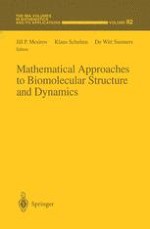This IMA Volume in Mathematics and its Applications MATHEMATICAL APPROACHES TO BIOMOLECULAR STRUCTURE AND DYNAMICS is one of the two volumes based on the proceedings of the 1994 IMA Sum mer Program on "Molecular Biology" and comprises Weeks 3 and 4 of the four-week program. Weeks 1 and 2 appeared as Volume 81: Genetic Mapping and DNA Sequencing. We thank Jill P. Mesirov, Klaus Schulten, and De Witt Sumners for organizing Weeks 3 and 4 of the workshop and for editing the proceedings. We also take this opportunity to thank the National Institutes of Health (NIH) (National Center for Human Genome Research), the National Science Foundation (NSF) (Biological Instrumen tation and Resources), and the Department of Energy (DOE), whose fi nancial support made the summer program possible. A vner Friedman Robert Gulliver v PREFACE The revolutionary progress in molecular biology within the last 30 years opens the way to full understanding of the molecular structures and mech anisms of living organisms. Interdisciplinary research in mathematics and molecular biology is driven by ever growing experimental, theoretical and computational power. The mathematical sciences accompany and support much of the progress achieved by experiment and computation as well as provide insight into geometric and topological properties of biomolecular structure and processes. This volume consists of a representative sample of the papers presented during the last two weeks of the month-long Institute for Mathematics and Its Applications Summer 1994 Program in Molecular Biology.
